The Effect of Sandblasting on Properties and Structures of the DC03/1.0347, DC04/1.0338, DC05/1.0312, and DD14/1.0389 Steels for Deep Drawing
Abstract
1. Introduction
2. Materials and Methods
2.1. Chemical Composition Analysis
2.2. Static Tensile Tests
2.3. Drawability Tests
2.4. Erosion Tests
2.5. Steel Sheet Thickness at the Erosion Region
2.6. The Analysis of the Microstructure
2.7. Hardness of Steel Sheets
2.7.1. In the Plane of Rolling before Erosion Test
2.7.2. After Erosion Test in the Cross-Section of the Sample and under Low Load
2.8. Surface Roughness Measurements
3. Results
3.1. Chemical Composition Analysis
3.2. Static Tensile Test
3.3. Drawability Tests
3.4. The Analysis of Microstructures of the Investigated Steels before Erosion Treatment
3.5. The Hardness of the Steel Sheet in the Rolling Plane
3.6. Weight Loss Measurements
3.7. Surface Roughness Analysis
3.8. Hardness of Steel Sheets after Erosion Treatment in Their Cross-Section
3.9. Qualitative Analysis of Steel Sheets Microstructure at Cross-Sections after Erosion Tests
- Formation of austenite and its strong deformation;
- Formation of austenite and its dynamic recrystallization;
- Plastic deformation of ferrite and its dynamic recrystallization;
- Plastic deformation of ferrite and its dynamic recovery;
- Plastic deformation of ferrite;
- No influence of erosion on the microstructure in the center of the steel sheet.
3.10. Quantitative Analysis of the Microstructure
4. Discussion
5. Conclusions
- (1)
- An increase in strength properties increases the resistance to erosive wear.
- (2)
- Significant results of the erosive treatment are microstructural changes affecting the material properties.
- (3)
- There is a correlation between the microstructure and the erosive wear mechanisms.
- (4)
- The erosive wear mechanisms and their intensity obviously change with the distance from the erosive stream axis.
- (5)
- There is a correlation between an increase in hardness and an increase in surface roughness with the grain refinement, and with a reduction in the sheet thickness (mass wear).
- (6)
- Extending the time of erosive impact does not change both the nature of changes in the investigated material and aerological parameters; the distance from the erosive stream axis only changes their intensity.
Author Contributions
Funding
Institutional Review Board Statement
Informed Consent Statement
Data Availability Statement
Acknowledgments
Conflicts of Interest
References
- Xu, Y.; Liu, L.; Zhou, Q.; Wang, X.; Tan, M.Y.; Huang, Y. An Overview of Major Experimental Methods and Apparatus for Measuring and Investigating Erosion-Corrosion of Ferrous-Based Steels. Metals 2020, 10, 180. [Google Scholar] [CrossRef]
- Blatnický, M.; Dižo, J.; Sága, M.; Kopas, P. Applied Research of Applicability of High-Strength Steel for a Track of a Demining Machine in Term of Its Tribological Properties. Metals 2021, 11, 505. [Google Scholar] [CrossRef]
- Alhussein, A.; Capelle, J.; Gilgert, J.; Tidu, A.; Hariri, S.; Azari, Z. Static, dynamic and fatigue characteristics of the pipeline API 5L X52 steel after sandblasting. Eng. Fail. Anal. 2013, 27, 1–15. [Google Scholar] [CrossRef]
- Jiang, X.P.; Wang, X.Y.; Li, J.X.; Li, D.Y.; Man, C.-S.; Shepard, M.J.; Zhai, T. Enhancement of fatigue and corrosion properties of pure Ti by sandblasting. Mater. Sci. Eng. A 2006, 429, 30–35. [Google Scholar] [CrossRef]
- Bresson, G.; Jumel, J.; Shanahan, M.E.R.; Serin, P. Strength of adhesively bonded joints under mixed axial and shear loading. Int. J. Adhes. Adhes. 2012, 35, 27–35. [Google Scholar] [CrossRef]
- Kumosa, L.; Armentrout, D.; Kumosa, D. The effect of sandblasting on the initiation of stress corrosion cracking in unidirectional E-glass/polymer composites used in high voltage composite (non-ceramic) insulators. Compos. Sci. Technol. 2002, 62, 1999–2015. [Google Scholar] [CrossRef]
- Bechikh, A.; Klinkova, O.; Maalej, Y.; Tawfiq, I.; Nasri, R. Sandblasting parameter variation effect on galvanized steel surface chemical composition, roughness and free energy. Int. J. Adhes. Adhes. 2020, 102, 102653. [Google Scholar] [CrossRef]
- Ding, L.; Torbati-Sarraf, H.; Poursaee, A. The influence of the sandblasting as a surface mechanical attrition treatment on the electrochemical behavior of carbon steel in different pH solutions. Surf. Coat. Technol. 2018, 352, 112–119. [Google Scholar] [CrossRef]
- Geng, S.; Sun, J.; Guo, L. Effect of sandblasting and subsequent acid pickling and passivation on the microstructure and corrosion behavior of 316L stainless steel. Mater. Des. 2015, 88, 1–7. [Google Scholar] [CrossRef]
- Bahadur, S.; Badruddin, R. Erodent particle characterization and the effect of particle size and shape on erosion. Wear 1990, 138, 1–2, 189–208. [Google Scholar] [CrossRef]
- Naz, M.Y.; Ismail, N.I.; Sulaiman, S.A.; Shukrullah, S. Erodent Impact Angle and Velocity Effects on Surface Morphology of Mild Steel. Proc. Eng. 2016, 148, 896–901. [Google Scholar] [CrossRef][Green Version]
- Alhussein, A.; Capelle, J.; Gilgert, J.; Dominiak, S.; Azari, Z. Influence of sandblasting and hydrogen on tensile and fatigue properties of pipeline API 5L X52 steel. Int. J. Hydrog. Energy 2011, 36, 2291–2301. [Google Scholar] [CrossRef]
- Multigner, M.; Frutos, E.; González-Carrasco, J.; Jiménez, J.; Marín, P.; Ibáñez, J. Influence of the sandblasting on the subsurface microstructure of 316LVM stainless steel: Implications on the magnetic and mechanical properties. Mater. Sci. Eng. C 2009, 29, 1357–1360. [Google Scholar] [CrossRef]
- Multigner, M.; Ferreira-Barragáns, S.; Frutos, E.; Jaafar, M.; Ibáñez, J.; Marín, P.; Pérez-Prado, M.; González-Doncel, G.; Asenjo, A.; González-Carrasco, J. Superficial severe plastic deformation of 316 LVM stainless steel through grit blasting: Effects on its microstructure and subsurface mechanical properties. Surf. Coat. Technol. 2010, 205, 1830–1837. [Google Scholar] [CrossRef]
- Chen, C.; Shang, C.J.; Li, D.Y. Surface nanocrystallization of Al-plated steel for application in the exhaust system of vehicles. Wear 2009, 267, 345–349. [Google Scholar] [CrossRef]
- Chen, C.; Li, D.Y.; Shang, C.J. Nanocrystallization of aluminized surface of carbon steel for enhanced resistances to corrosion and corrosive wear. Electrochim. Acta 2009, 55, 118–124. [Google Scholar] [CrossRef]
- Peng, R.; Fu, L.; Zhou, L. Improved wear resistance by phase transformation of surface nanocrystalline 1090 steel prepared by sandblasting technique. Appl. Surf. Sci. 2016, 388, 406–411. [Google Scholar] [CrossRef]
- Ding, L.; Poursaee, A. The impact of sandblasting as a surface modification method on the corrosion behavior of steels in simulated concrete pore solution. Constr. Build. Mater. 2017, 157, 591–599. [Google Scholar] [CrossRef]
- Pour-Ali, S.; Kiani-Rashid, A.-R.; Babakhani, A. Surface nanocrystallization and gradient microstructural evolutions in the surface layers of 321 stainless steel alloy treated via severe shot peening. Vacuum 2017, 144, 152–159. [Google Scholar] [CrossRef]
- Suyitno, S.; Ishak. The Influence of Sandblasting and Electropolishing on the Surface Hardness of AISI 316L Stainless Steel. Adv. Mater. Res. 2014, 896, 517–520. [Google Scholar] [CrossRef]
- Isa, M.; Zaroog, O.; Yunus, M.; Sanny, B.V.; Rosmi, N. Effect of Sandblasting Process on Mechanical Properties of ASTM A516 Grade 70 Steel. Key Eng. Mater. 2018, 765, 222–226. [Google Scholar] [CrossRef]
- Basir, M.H.M.; Abdullah, B.; Idham, M.F.; Ismail, M.H. Effect of Shot Blasting on Paste Boronizing of 316LStainless Steel. Key Eng. Mater. 2017, 740, 25–30. [Google Scholar] [CrossRef]
- Rudawska, A.; Danczak, I.; Müller, M.; Valasek, P. The effect of sandblasting on surface properties for adhesion. Int. J. Adhes. Adhes. 2016, 70, 176–190. [Google Scholar] [CrossRef]
- Remes, H.; Korhonen, E.; Lehto, P.; Romanoff, J.; Niemelä, A.; Hiltunen, P.; Kontkanen, T. Influence of surface integrity on the fatigue strength ofhigh-strength steels. J. Construct. Steel Res. 2013, 89, 21–29. [Google Scholar] [CrossRef]
- Melentiev, R.; Fang, F. Recent advances and challenges of abrasive jet machining. CIRP J. Manuf. Sci. Tec. 2018, 22, 1–20. [Google Scholar] [CrossRef]
- Biswas, S.; Cenna, A.; Williams, K.; Jones, M. Subsurface behavior of ductile material by particle impacts and its influence on wear mechanism. Proc. Eng. 2014, 90, 160–165. [Google Scholar] [CrossRef][Green Version]
- Rodríguez, E.; Flores, M.; Pérez, A.; Mercado-Solis, R.D.; González, R.; Rodríguez, J.; Valtierra, S. Erosive wear by silica sand on AISI H13 and 4140 steels. Wear 2009, 267, 2109–2115. [Google Scholar] [CrossRef]
- Okonkwo, P.C.; Shakoor, R.A.; Ahmed, E.; Mohamed, A.M.A. Erosive wear performance of API X42 pipeline steel. Eng. Fail. Anal. 2016, 60, 86–95. [Google Scholar] [CrossRef]
- PN-EN ISO 6892-1:2020-05. Metals-Tensile Testing—Part 1: Room Temperature Testing Method; Polish Committee for Standardization: Warsaw, Poland, 2020. [Google Scholar]
- PN-EN ISO 20482:2014-02. Metals-Sheets and Strips—Erichsen Method for Formability Testing; Polish Committee for Standardization: Warsaw, Poland, 2014. [Google Scholar]
- PN-EN 10130:2009. Cold Rolled Flat Products of Low Carbon Steel for Cold Working—Technical Delivery Conditions; Polish Committee for Standardization: Warsaw, Poland, 2009. [Google Scholar]
- PN-EN 10111:2009. Continuously Hot Rolled Low Carbon Steel Sheets and Strips for Cold Working—Technical Delivery Conditions; Polish Committee for Standardization: Warsaw, Poland, 2009. [Google Scholar]
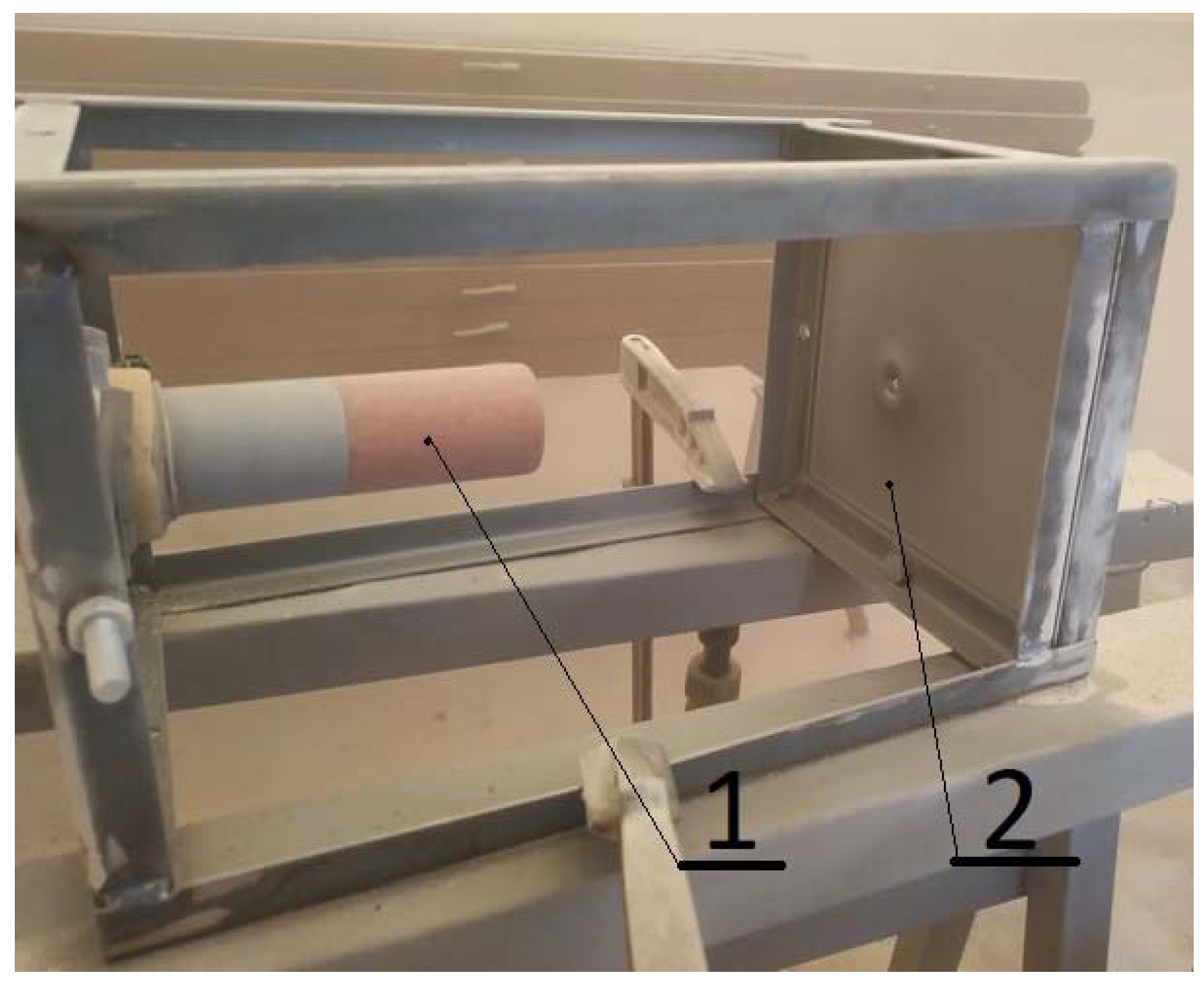


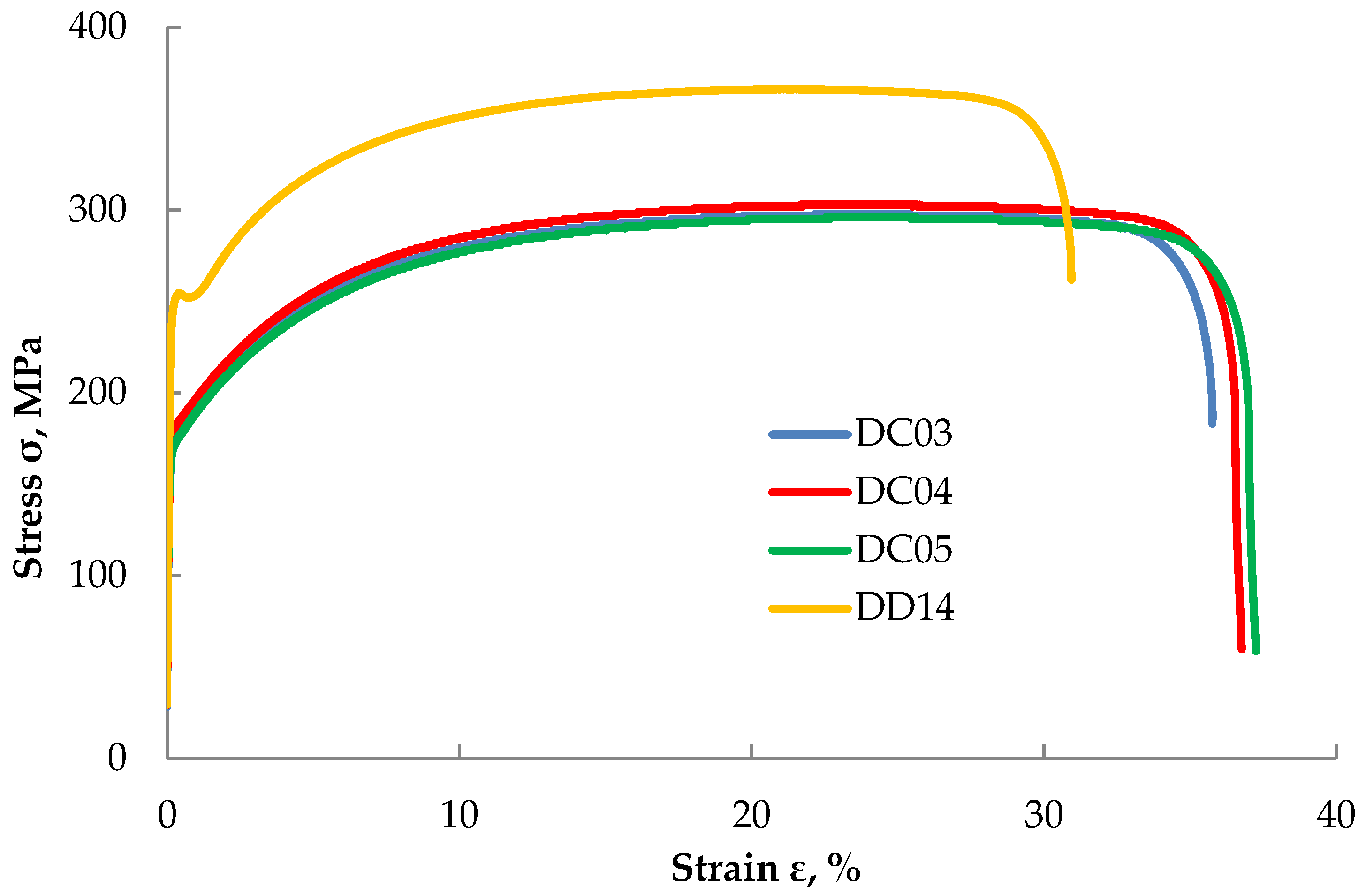

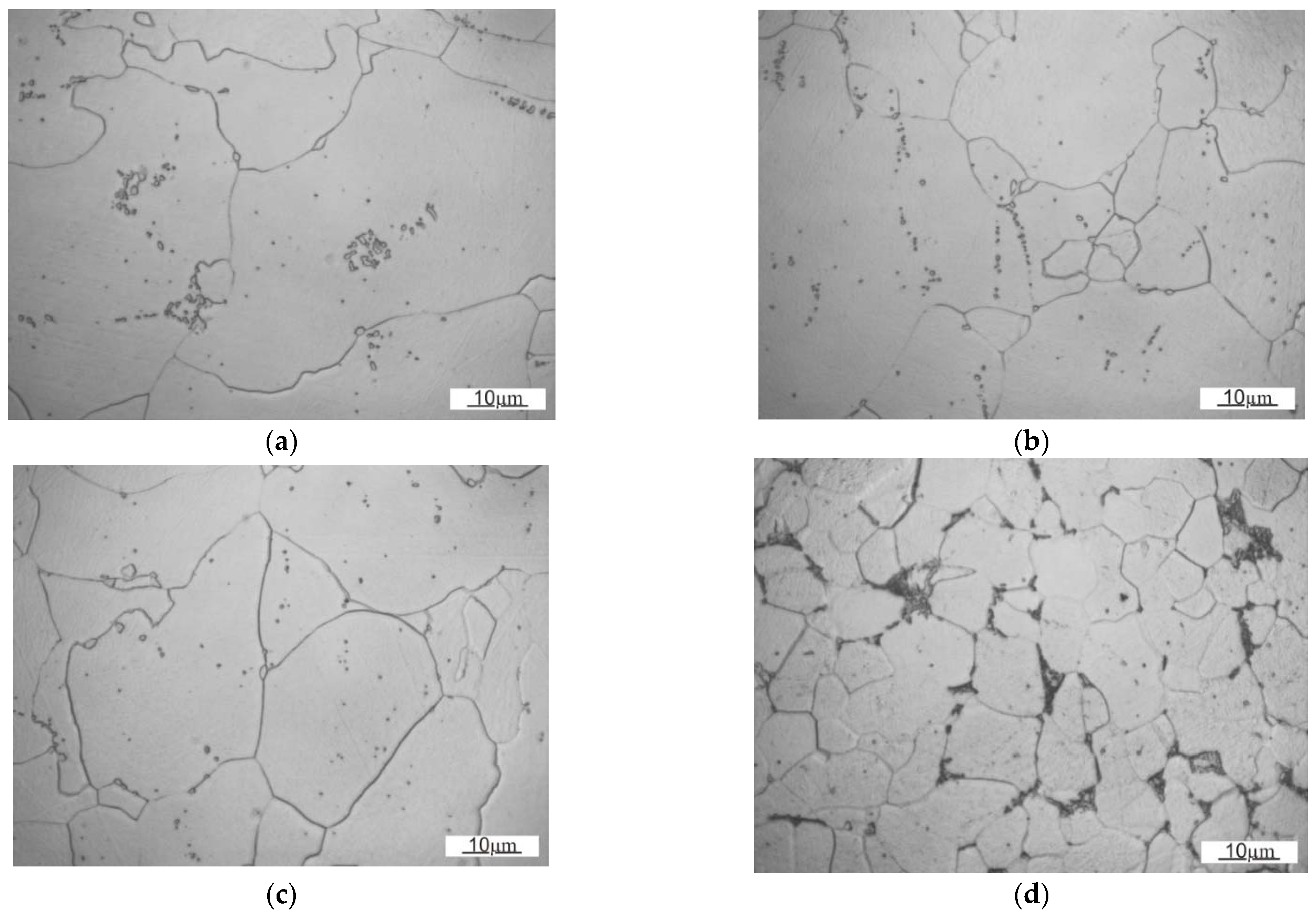
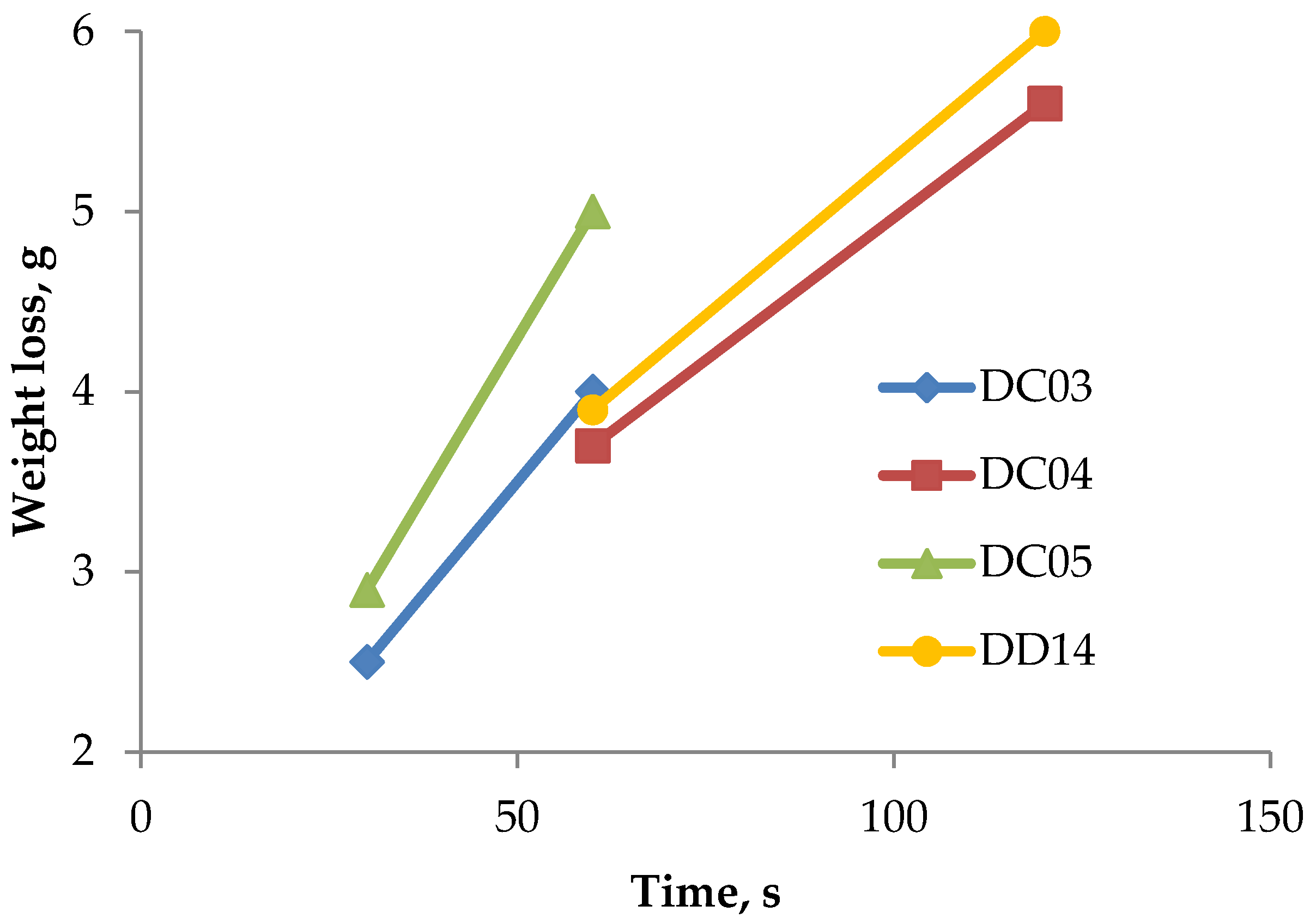
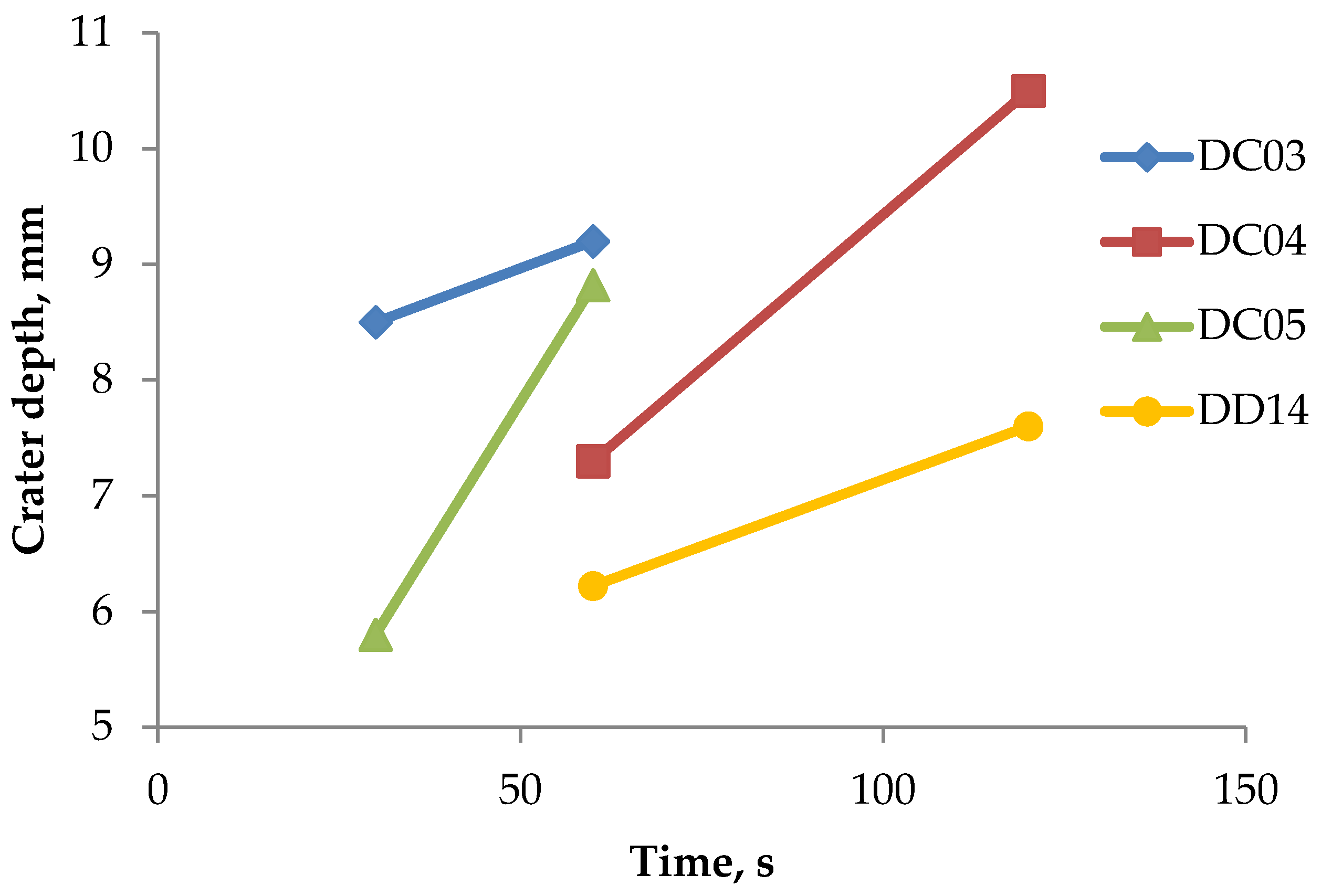
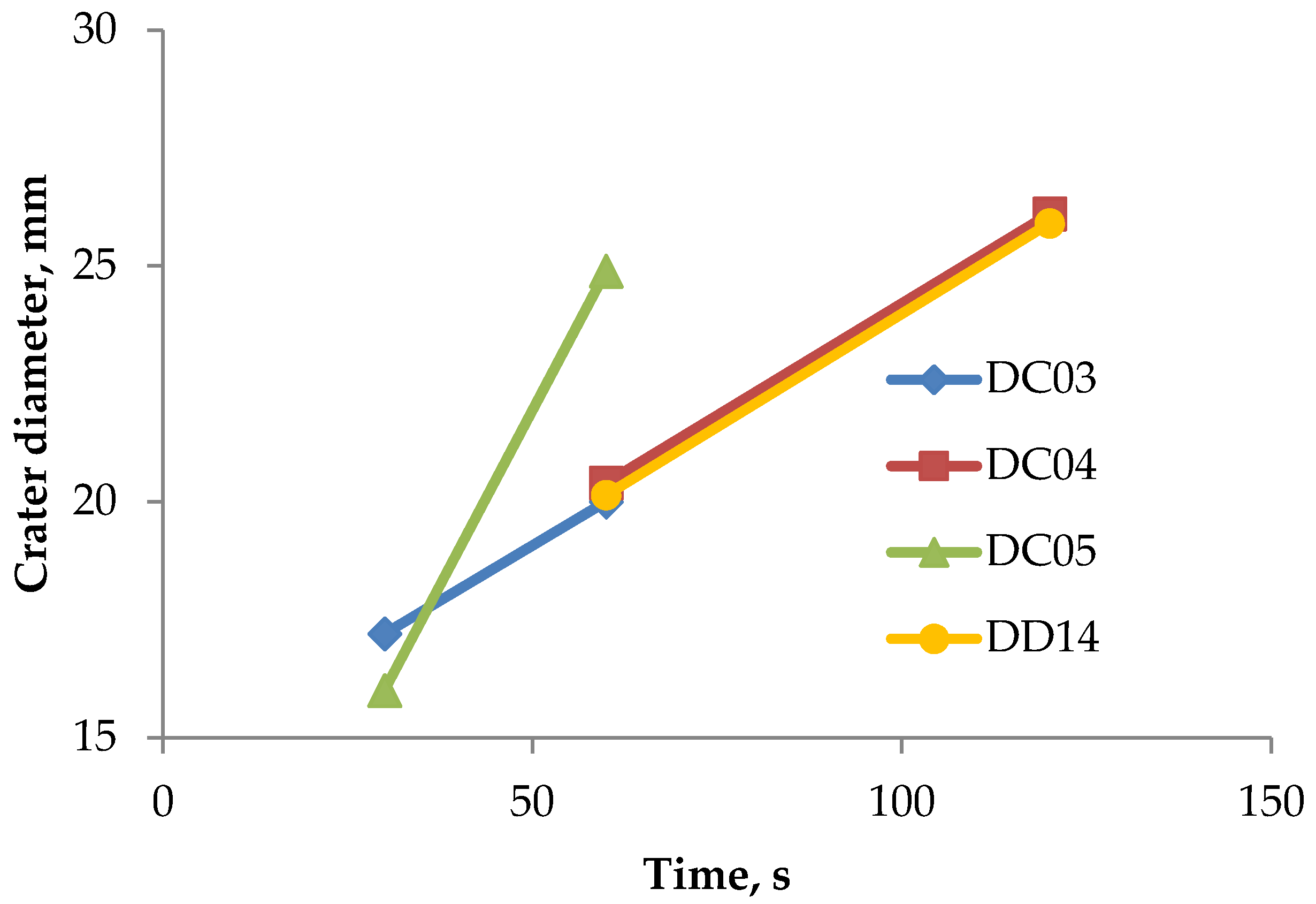
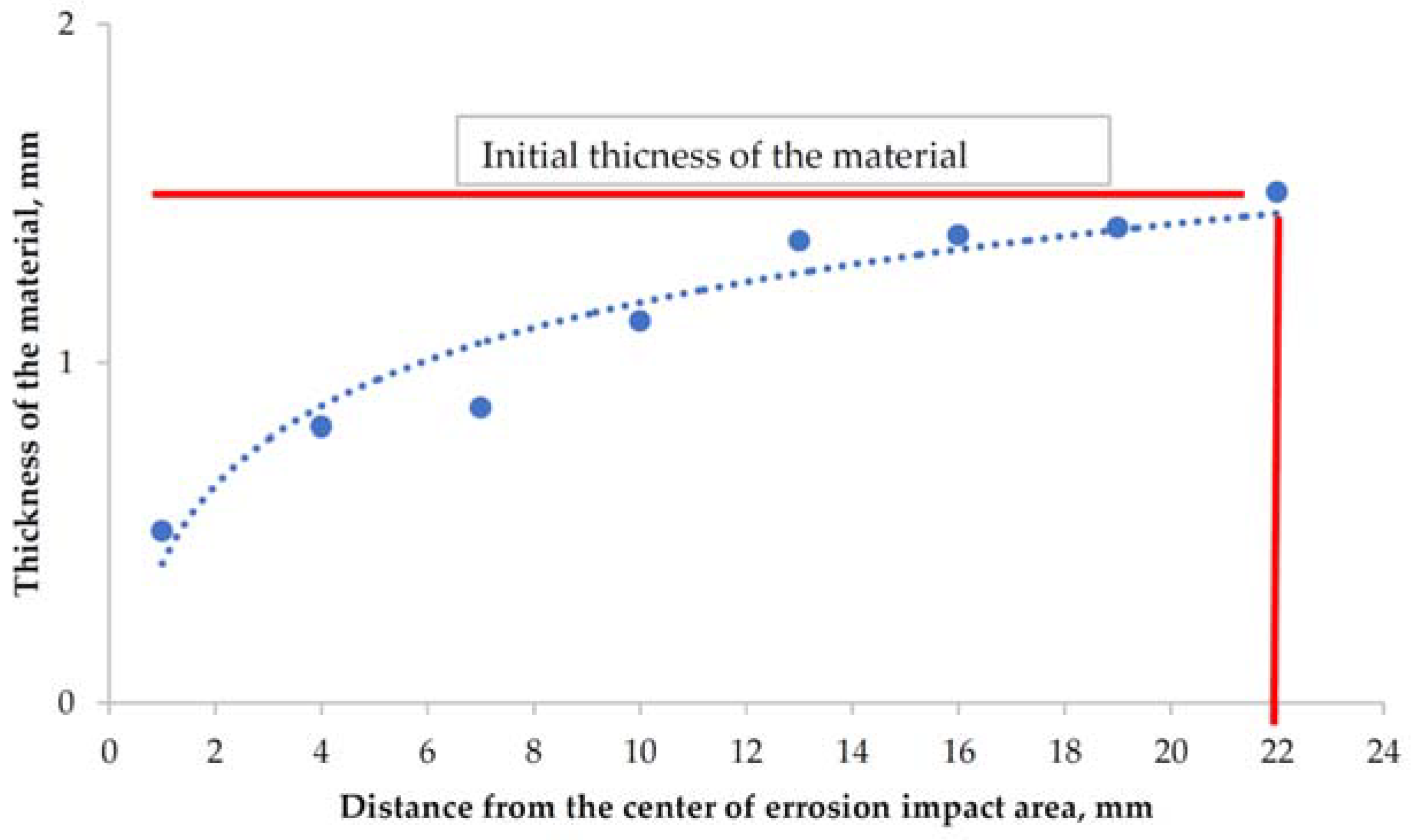
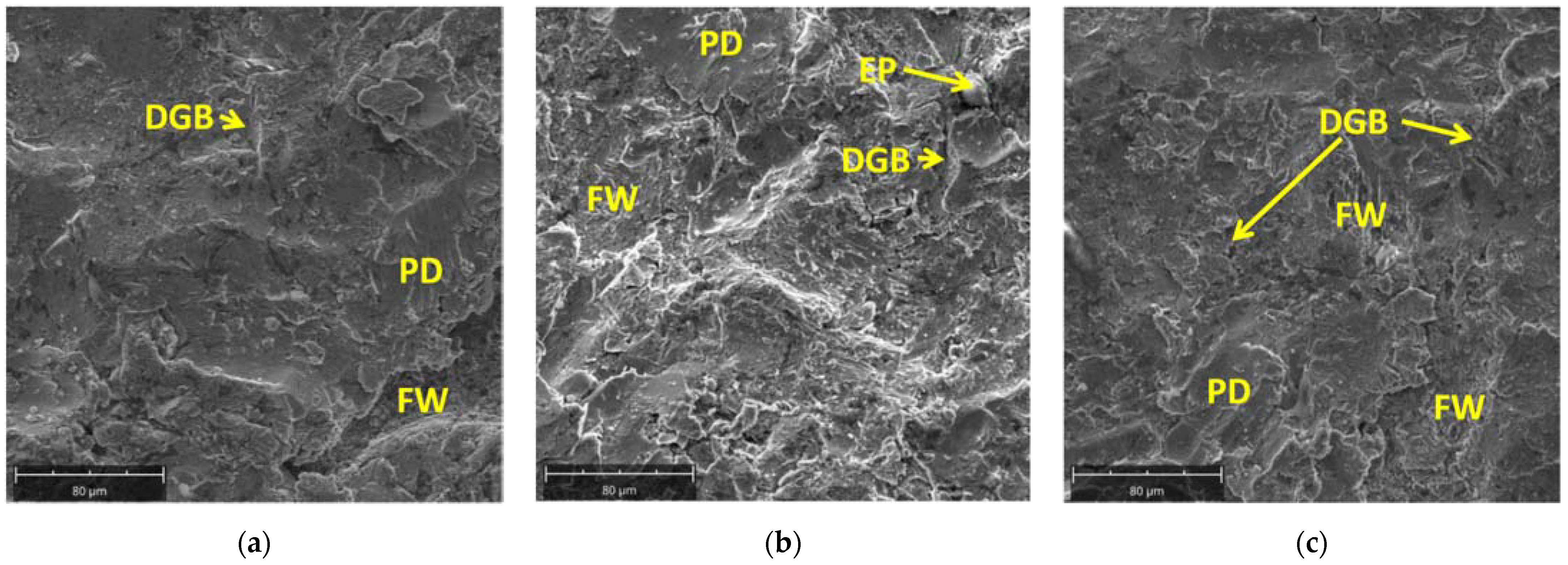
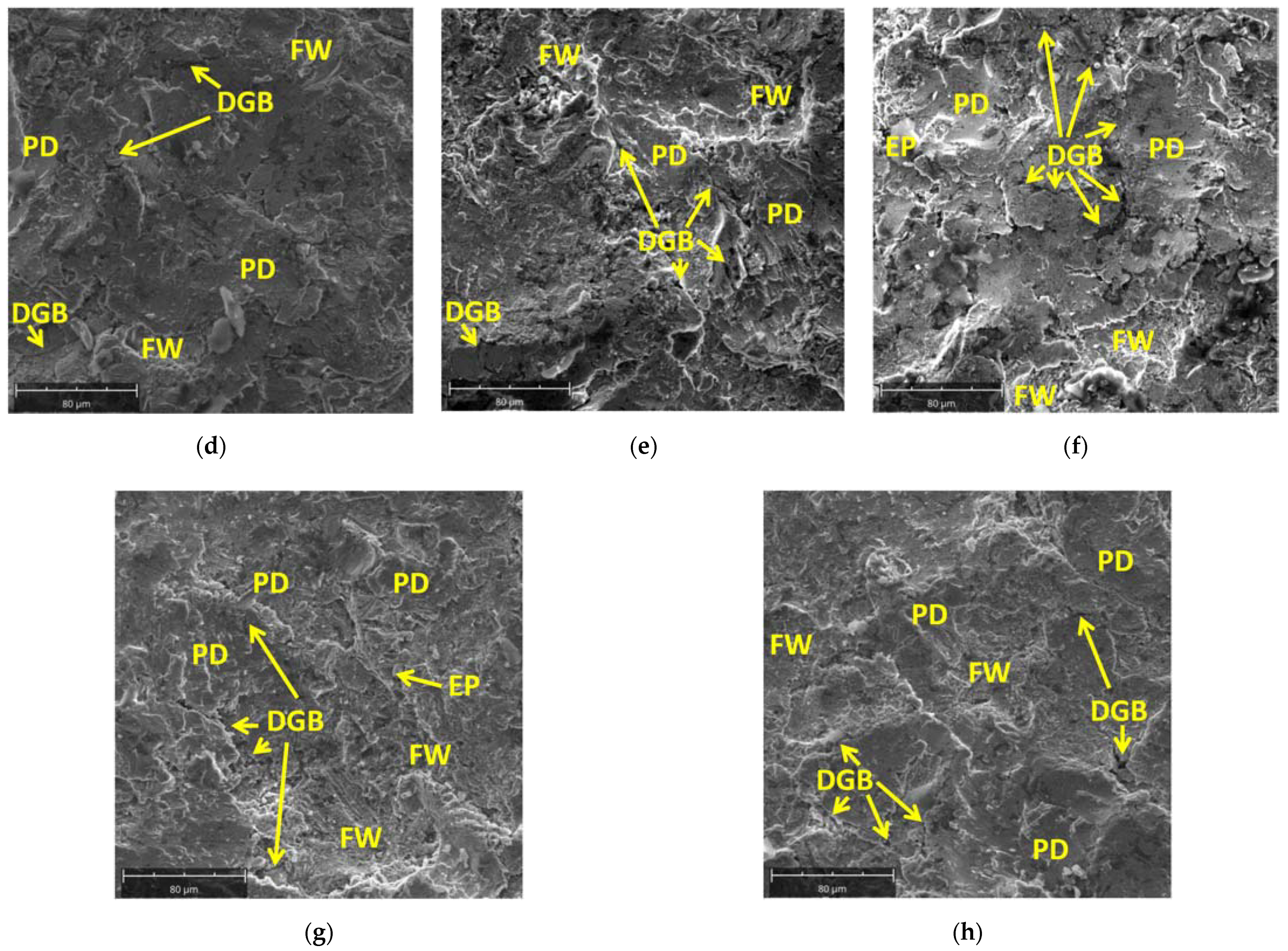
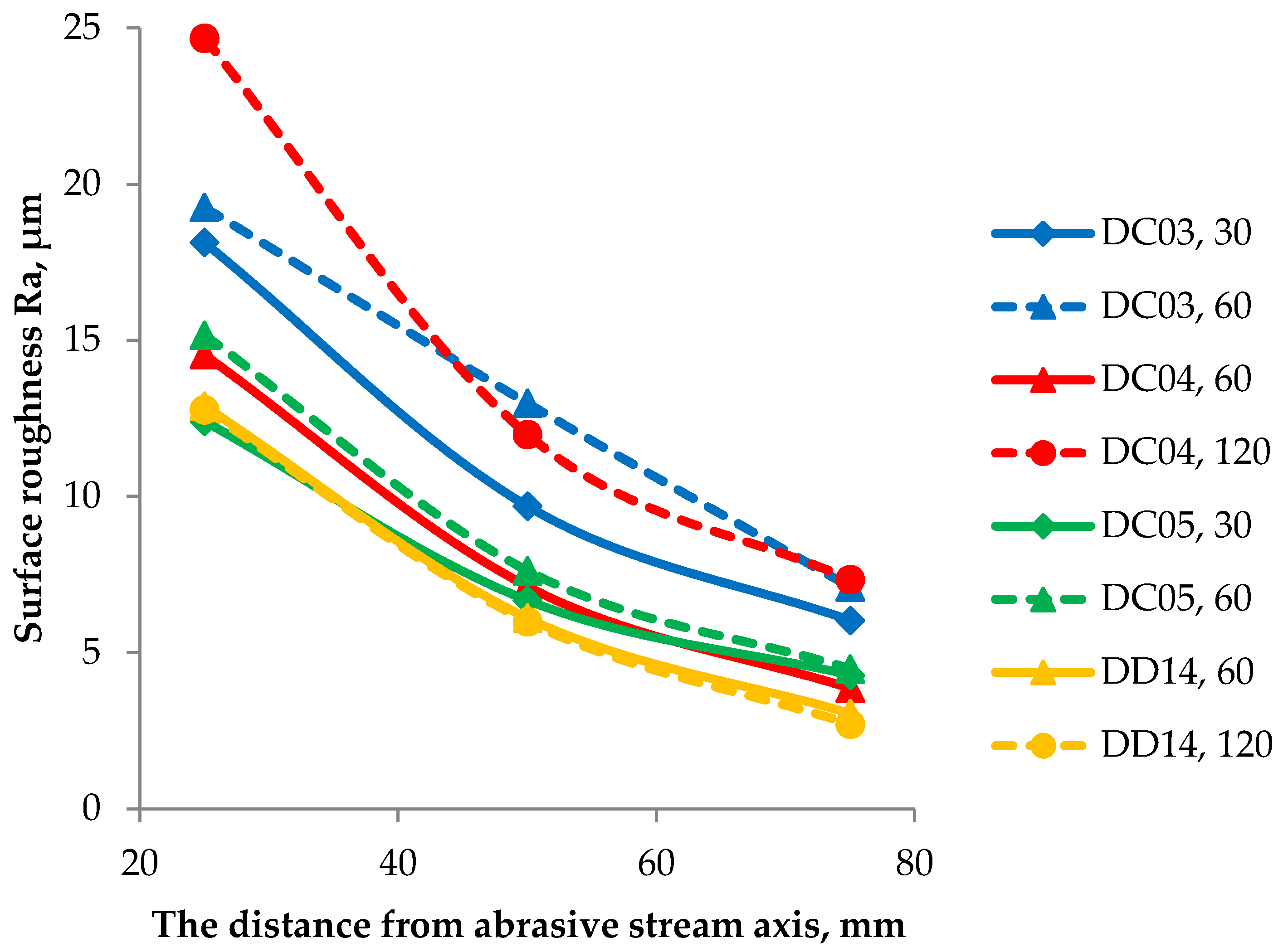



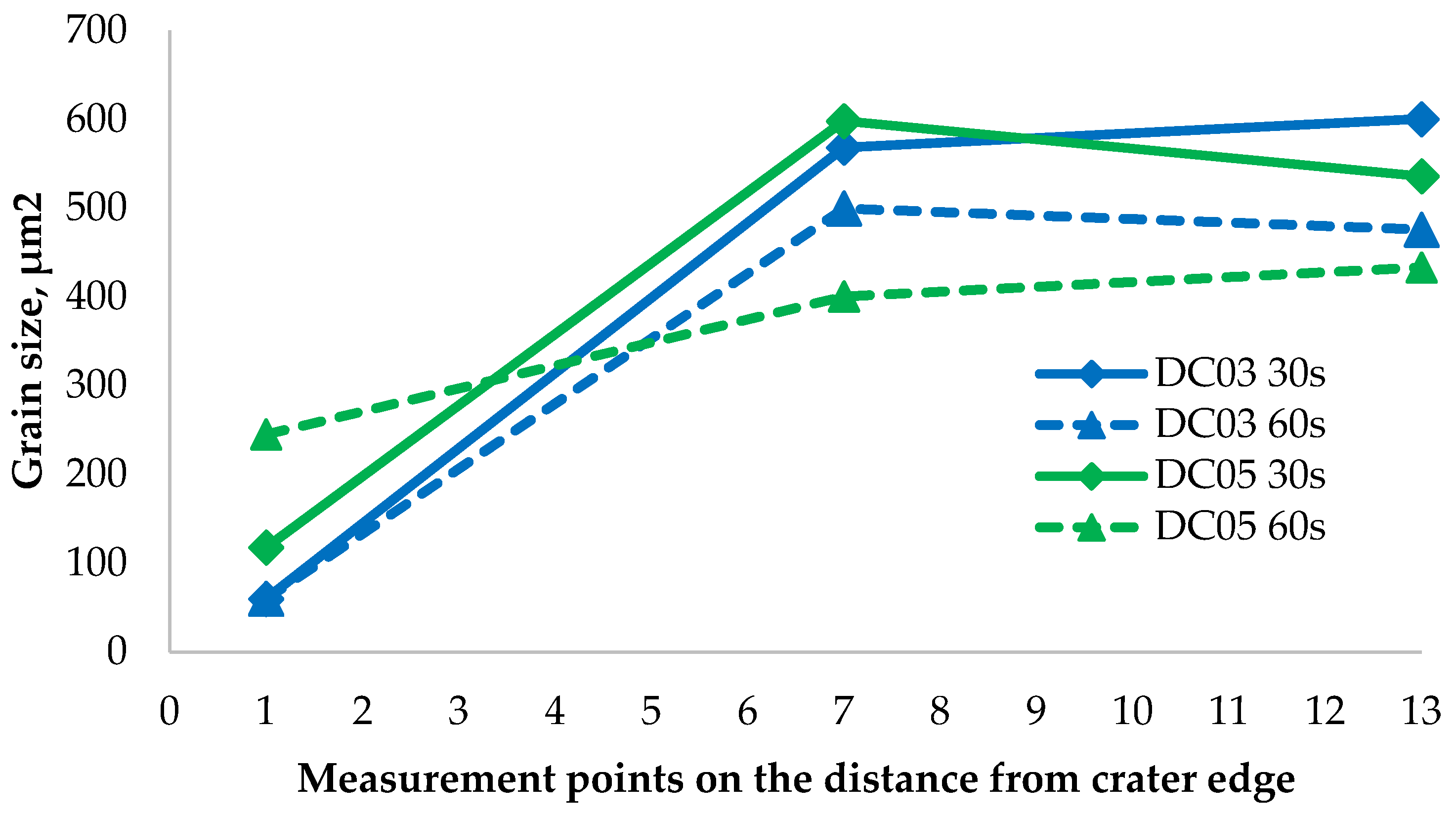
| Erosion Time, s | |||
|---|---|---|---|
| Steel Grade | 30 | 60 | 120 |
| DC03 | × | × | |
| DC04 | × | × | |
| DC05 | × | × | |
| DD14 | × | × | |
| Chemical Composition, wt. % | ||||||||
|---|---|---|---|---|---|---|---|---|
| C | Mn | P | S | Si | Cr | Al | Cu | |
| DC03 | 0.070 ± 0.019 | 0.21 ± 0.01 | 0.015 ± 0.003 | 0.012 | <0.005 | 0.02 | 0.057 | 0.02 |
| DC04 | 0.071 ± 0.026 | 0.24 ± 0.02 | 0.012 ± 0.001 | 0.007 | 0.06 | 0.02 | 0.076 | 0.04 |
| DC05 | 0.061 ± 0.016 | 0.22 ± 0.01 | 0.011 ± 0.001 | 0.005 | 0.07 | 0.01 | 0.067 | 0.02 |
| DD14 | 0.078 ± 0.007 | 0.30 ± 0.01 | 0.011 ± 0.002 | 0.008 | <0.005 | 0.01 | 0.054 | 0.03 |
| Chemical Element, wt. % | ||||
|---|---|---|---|---|
| Type of Steel | C | P | S | Mn |
| DC03 | 0.10 | 0.035 | 0.035 | 0.45 |
| DC04 | 0.08 | 0.030 | 0.030 | 0.40 |
| DC05 | 0.06 | 0.025 | 0.025 | 0.35 |
| DD14 | 0.08 | 0.025 | 0.025 | 0.35 |
| DC03 | DC04 | DC05 | DD14 | |
|---|---|---|---|---|
| Rp0.2, MPa | 175 | 180 | 172 | - |
| ReH, MPa | - | - | - | 251 |
| ReL, MPa | - | - | - | 249 |
| Rm, MPa | 298 | 303 | 296 | 361 |
| E, GPa | 197 | 207 | 193 | 205 |
| DC03 | DC04 | DC05 | DD14 | |
|---|---|---|---|---|
| Depth of the draw, mm | 12.85 | 12.65 | 12.86 | 12.57 |
| Plane RD-STD, µm2 | Plane LTD-STD, µm2 | Plane RD-LTD, µm2 | |
|---|---|---|---|
| DC03 | 399 ± 20 | 432 ± 22 | 411 ± 21 |
| DC04 | 370 ± 18 | 393 ± 20 | 648 ± 32 |
| DC05 | 295 ± 15 | 360 ± 18 | 786 ± 39 |
| DD14 | 66 ± 3 | 68 ± 3 | 115 ± 6 |
| DC03 | DC04 | DC05 | DD14 |
|---|---|---|---|
| 77 | 72 | 70 | 106 |
| Steel | 30 s | 60 s | 120 s | |||
|---|---|---|---|---|---|---|
| mm | g | mm | g | mm | g | |
| DC03 | 17.2/8.5 * | 2.5 | 20/9.2 * | 4.0 | - | - |
| DC04 | - | - | 20.4/7.3 * | 3.7 | 26.1/10.5 * | 5.6 |
| DC05 | 16/5.8 * | 2.9 | 24.89/8.82 * | 5.0 | - | - |
| DD14 | - | - | 20.14/6.22 | 3.9 | 25.9/7.6 | 6.0 |
Publisher’s Note: MDPI stays neutral with regard to jurisdictional claims in published maps and institutional affiliations. |
© 2021 by the authors. Licensee MDPI, Basel, Switzerland. This article is an open access article distributed under the terms and conditions of the Creative Commons Attribution (CC BY) license (https://creativecommons.org/licenses/by/4.0/).
Share and Cite
Krawczyk, J.; Bembenek, M.; Frocisz, Ł.; Śleboda, T.; Paćko, M. The Effect of Sandblasting on Properties and Structures of the DC03/1.0347, DC04/1.0338, DC05/1.0312, and DD14/1.0389 Steels for Deep Drawing. Materials 2021, 14, 3540. https://doi.org/10.3390/ma14133540
Krawczyk J, Bembenek M, Frocisz Ł, Śleboda T, Paćko M. The Effect of Sandblasting on Properties and Structures of the DC03/1.0347, DC04/1.0338, DC05/1.0312, and DD14/1.0389 Steels for Deep Drawing. Materials. 2021; 14(13):3540. https://doi.org/10.3390/ma14133540
Chicago/Turabian StyleKrawczyk, Janusz, Michał Bembenek, Łukasz Frocisz, Tomasz Śleboda, and Marek Paćko. 2021. "The Effect of Sandblasting on Properties and Structures of the DC03/1.0347, DC04/1.0338, DC05/1.0312, and DD14/1.0389 Steels for Deep Drawing" Materials 14, no. 13: 3540. https://doi.org/10.3390/ma14133540
APA StyleKrawczyk, J., Bembenek, M., Frocisz, Ł., Śleboda, T., & Paćko, M. (2021). The Effect of Sandblasting on Properties and Structures of the DC03/1.0347, DC04/1.0338, DC05/1.0312, and DD14/1.0389 Steels for Deep Drawing. Materials, 14(13), 3540. https://doi.org/10.3390/ma14133540







